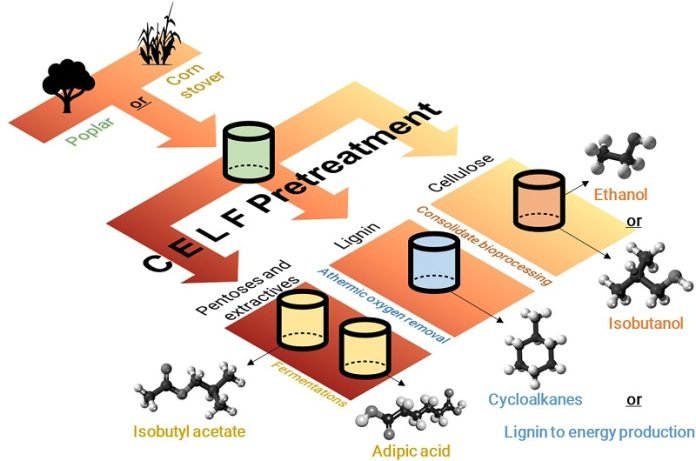
Creating fuel from plants sounds like something from the future, but scientists have been working on it for years.
The big challenge?
Plants are tough, and breaking them down to make fuel has been too expensive and complicated—until now.
A new discovery by researchers, including a team from UC Riverside, is changing the game, making biofuels from plants not just a dream but a practical, eco-friendly solution.
At the heart of the problem is a substance called lignin. Lignin is what makes plants sturdy, helping them stand tall and resist bugs.
But this toughness also makes lignin a tough nut to crack when it comes to turning plants into biofuels. For biofuels to really take off and compete with traditional petroleum-based fuels, scientists knew they had to find a better way to deal with lignin.
Enter CELF, a smart new method developed by Associate Research Professor Charles Cai and his team.
CELF stands for co-solvent enhanced lignocellulosic fractionation, but in simple terms, it’s a way to prep plants so that we can get both the sugars and lignin out more easily and use them to make fuel.
CELF works by adding a special ingredient called tetrahydrofuran (THF) to the mix. THF is cool because it can be made from the same sugars in plants that are being turned into biofuel.
By using THF in the process, the team found they could not only break down the plant material more efficiently but also pull out valuable lignin to use as well.
This discovery could mean big things for biofuels. A recent study published in Energy & Environmental Science shows that using CELF could make producing biofuels from plants both cheaper and better for the planet than ever before. This method has the potential to lower the cost of biofuels and make them a real competitor to fossil fuels.
Why does this matter?
Well, for starters, using plants for fuel instead of drilling for oil is way better for the environment. Plants are renewable, meaning we can grow more of them, and using them for fuel doesn’t add extra carbon dioxide to the atmosphere the way burning fossil fuels does.
Plus, the Department of Energy thinks the U.S. could use this technology to replace 30% of its petroleum use with biofuels, creating jobs and helping the environment at the same time.
The researchers also looked into what kind of plants would be best for this process. They found that hardwood poplar, a type of tree, is better than corn leftovers because poplar is denser and has more lignin. This means more fuel can be made from less plant material.
What’s next? The team at UC Riverside is working on scaling up their process. They’ve got a new 20-gallon reactor to test their method on a larger scale, hoping to bring this technology to a point where it can be used by biofuel producers all over the country.
This breakthrough in biofuels from plants is not just good news for the environment; it’s a step towards a future where our cars, trucks, and buses run on clean, green fuel.
It’s a win-win for the planet and our pockets, making the dream of sustainable, affordable biofuels a reality.



